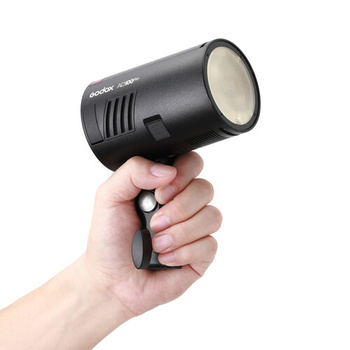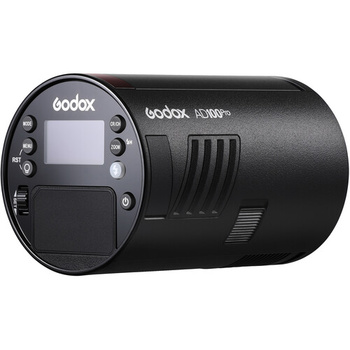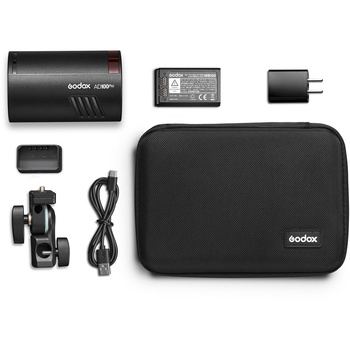Godox’s line of flashes, including the incredibly popular AD200 and V1, have become a mainstay of the on and off-camera lighting market. They’ve become so popular, in part, thanks to the surprising value and feature set offered at each price point. As a result, the AD100Pro, a new addition to the line, has quite the legacy to live up to. Has it earned a place in photographer’s bags?
The Light
Godox’s AD series, perhaps most notable for that aforementioned AD200, spans quite a range. The AD200, at 200Ws, features a much sleeker form-factor than the larger monolight style lights, like the AD300 or AD600, capable of 300 and 600Ws respectively. As you might guess from the name, the AD100Pro fits in below the AD200 in output, with an output of about 100Ws (more on why that isn’t the whole story in a minute). 
What the name doesn’t capture, however, is how much more compact the light is. Essentially the size and shape of a soda can, it is more portable than even a large speedlight, in my opinion. It easily fits in the lens slot of any camera bag, and you could stack 4 of them in the space occupied by 2 AD200s. In case you don’t know, the AD100, like others in the family, features a lithium-ion battery, making it an entirely self-contained setup for up to 360 1/1 power flashes.
Another great feature of the AD family of products is the compatibility with Godox’s 2.4G wireless system. These X-family triggers are another great value, particularly when compared to other company’s wireless triggers. They have versions compatible with every major camera manufacturer, letting them offer TTL flash, high-speed sync, and full wireless control.
In Use
One of my favorite things about Godox’s lights is how easy they are to get started with. When using a compatible trigger, you have full TTL and reliable triggering, resulting in a better experience than Nikon’s first-party CLS solution. CLS relied on infrared, making it perform poorly outside of direct, near range line of sight. Meanwhile, Godox’s built-in X trigger system is 2.4Ghz wireless, and is effective at a range of 100m.
Besides being easy to set up and work with, the AD100Pro comes in a full-featured kit. In the box is a very nice quality zippered case, with room for the flash and all the included accessories. These accessories include a USB C charger and cable for the included battery (which is also compatible with the V1), as well as a nice bracket. The bracket mounts via thumbscrew to the threaded hole on the underside of the flash, can be tilted, and includes a hole for an umbrella or similar modifier to mount.
The flash turns on with a single click and scroll on the wheel to unlock, and pairs automatically with a trigger (I prefer the X Pro trigger’s massive display and dial interface, but you can also use their other triggers or even the v1 flash as a master). From here, you can use TTL or manual power modes, or switch to something more niche, like the included stroboscopic mode. If you prefer to set your flash directly, the interface is very simple. The flash features hardware buttons for all the major functions, like zoom, mode, modeling light power, and test triggering.
The LCD is very easy to read and should be easy to read under any lighting conditions where you’d expect to use the flash – the white on black text may be slightly less legible under very bright sunlight. To go along with the display, there’s a scroll and click dial, which makes navigating the deeper menu easy, although a few of these functions will need to be changed frequently.
The flash output can be set anywhere from 1/1 to 1/256. At full power, recycle time is quite quick, at 1.2 seconds. Thanks to the typically-off fan, the flash is silent in normal operation, but can still do many full power pops before appreciably slowing down.
The head also features a modeling light, but it is very weak. With even basic modifiers on, it’s virtually invisible.
Thanks to the design of the round head, the AD100 is compatible with the AK-R1 set of accessories. These magnetic-mounting modifiers include a barn door, snoot, grid, gels, and soft dome head.
Why the AD100Pro?
I think the AD100 fills a very specific niche in the Godox lineup. Thanks to the size and ease of use, as well as the flexibility of the round fresnel head, this light is a perfect location light. Shooting one or two people? It’s easy to manage and quick to set up, and won’t be particularly limited by the lower output compared to the larger lights in the lineup. Furthermore, it’s a great option if you’re already integrated into the Godox ecosystem, and need a 3rd light for something like a hair light.
If you’re not already in the flash system, it can be a very cost-effective entry point to working with off-camera flash. 1 or 2 AD100s, a trigger like the X1 or X Pro, and some light stands and umbrellas are all you’d need to get started. The size and lighting philosophy isn’t much different to speedlights, but can offer enough additional power to really fill a softbox, or shoot more quickly without bumping into recycling times.
I’m personally excited to add this to my wedding kit. Small and sleek, this light is easy to add to a bag, and easy to deploy, without being so intrusive to disrupt the event itself. At only 500 grams, it’s easy to toss a few in my bag and not worry about carrying them around, while still having more power than a similar set of speedlights.
One of the most immediate comparisons that come to mind is with the flash’s bigger brother. The AD200 and AD200Pro are well established and well regarded, offering twice the rated output of the AD100Pro. This doesn’t tell the whole story, however. The AD200 features a different head design than the AD100. The 100’s round, zoomable, fresnel head lets you concentrate light, or generate a softer spill without a modifier, compared to the default options for the 200. The 200 does have a round head similar to the AD100’s available, but it’s a separate purchase. In the end, it’s more powerful than the AD200 with a round head, and only about a stop and a half less powerful than the AD200 with a fresnel head.
Overall, I really enjoyed working with the AD100Pro. Like every Godox product I’ve used, it’s been thoughtfully engineered and offers performance well above the price point. I think the AD100Pro’s biggest issue is the strength of the other products in the lineup. The AD200 and 200Pro offer some more power for a similar price point, while still being close enough in form factor to be comparable. The V1, which takes the same batteries and accessories, as well as the option to be used on-camera or as a master, is another great product.
Compared to Godox’s other lights, the AD100 seems to be built with a very specific purpose in mind: get enough power into as small of a light as possible. While the other products, notably the AD200, seem to be a bit more generalized (see the variety of head options available), the AD100 has specialized into being the best, most portable location lighting option around.
In the end, I think the AD100 is really optimized for photographers looking for the most portable kit possible – weddings, headshot photographers, and those who are already significantly invested in Godox gear can all find great uses for this light. It’d also make a fantastic accent light, hair light, or tertiary light for something like a pair of AD200s. It’s truly impressive to hold the light in your hand when you realize the output and functionality that’s crammed into it. The AD100 is available from B&H.
What I Liked
-
Form factor
-
Ease of use and interface
-
Godox’s X wireless system
-
Head design and quality of light
What Can Be Improved
-
Modeling light is weak
-
Price to power ratio is less favorable compared to the AD200